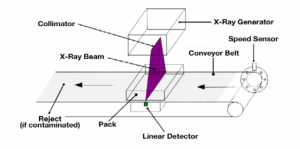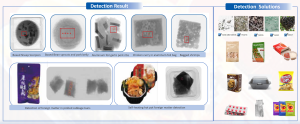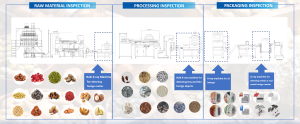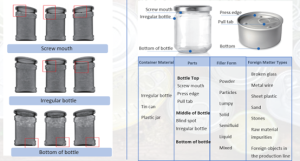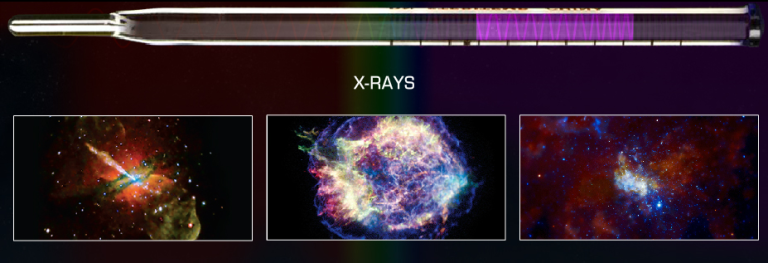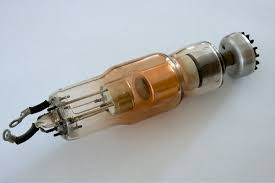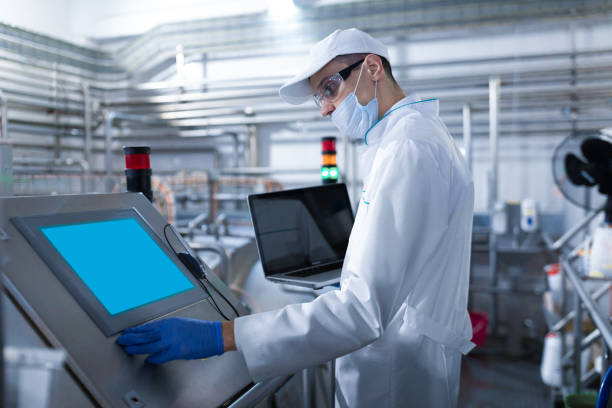Introduction
The Role of X-Ray Sources in Food Inspection
In order to ensure consumer safety and brand reputation, manufacturers need to control product quality and achieve full control of food safety from source to finished product. In this regard, there are many technologies that can be applied to food quality control, but X-ray inspection technology is the best choice. It can not only detect a variety of foreign contaminants other than non-metals, but also has high sensitivity and can detect almost all contaminants in food. It can also perform product and packaging integrity inspections, and it is safe because food does not absorb X-rays, and will not destroy the nutritional value of food and threaten consumer safety. X-ray inspection performance depends on the x ray generator, receiving coil, power supply, and software. This article will introduce different types of x-ray generators to help food X-ray system manufacturers choose the most suitable source.
Importance of Choosing the Right X-Ray Source
In the food industry, choosing the right x ray generator can not only improve the accuracy of foreign contaminant detection and realize the diversification of detection needs, but also reduce operating costs and improve production efficiency. Manufacturers need to select the right source based on product characteristics and inspection requirements, so that companies can maximize the advantages of x ray for food inspection and provide protection for consumer safety and brand reputation.
How X-ray Sources Work in X-ray Inspection Systems
X-ray sources play a vital role in x ray inspection for food industry, generating X-rays to penetrate objects and reveal hidden features. Here is a detailed explanation of how X-ray sources work.
Generation of X-rays
X-ray sources accelerate electrons through high voltages toward a target material (usually tungsten or molybdenum). When these high-energy electrons collide with the target, they release energy to form X-rays. These generated X-rays are directed at the object to be inspected.
Penetration and Detection
X-rays penetrate objects and interact with their internal structures. Denser materials (such as metal or bone) absorb more X-rays, while less dense materials (such as plastic or liquid) allow more X-rays to pass through. This difference in absorption creates a contrast that makes it easier for detectors on the other side of the object to capture these changes.
Image Generation
The detector converts the X-ray signal into a digital image. These images show the density differences of different materials inside the object. Next, software processes these images to identify unusual areas such as cracks, foreign contaminants or structural inconsistencies.
Data Analysis
Advanced algorithms and image processing software analyze the captured X-ray images to detect specific features or defects. For example, in quality control in food industry, the system can identify foreign contaminants such as metal, glass, or plastic in food based on the X-ray absorption pattern. The effectiveness of an X-ray machine depends on the sophistication of its data analysis.
Key Types of X-Ray Technologies Used in Food Inspection
Both single-energy and dual-energy X-ray technologies can be used for foreign contaminant detection in the food industry. However, the specific technology to choose depends on the possible contaminants and the type of product packaging materials that need to be inspected, the required production speed, and other factors such as the type of customer. Due to the wide variety of products produced in the food industry, the appropriate x ray technologies need to be selected according to the specific application scenario.
Single-Energy X-Ray Technology
Single-energy X-ray inspection equipment uses a single energy spectrum to detect stainless steel, ferrous metals, non-ferrous metals and other foreign materials in food, especially for foods with uniform density, such as butter, yogurt, etc. It can effectively identify foreign materials such as glass, calcified bone, mineral stones, and high-density plastics and rubber. However, the recognition ability may be weaker for foreign materials such as thin glass, stones, rocks or low-density plastics and rubber that may be contained in foods such as mixed nuts and hard candies.
Dual-Energy X-Ray Technology
Dual-energy X-ray inspection systems use two energy spectra with high sensitivity, especially for detecting flat glass, stones and low-density contaminants. These systems identify physical contaminants based on chemical composition, so they can more effectively detect inorganic foreign materials in products of various densities and textures, such as salads, mixed nuts or cereals. For manufacturers of foods that produce non-traditional packaging and multi-product packaging, dual-energy X-ray systems can produce images that remove the edges of the package to obtain a complete image of potential contaminants.
At the same time, dual-energy X-ray technology is also very suitable for detecting lower density contaminants, including cartilage, rubber, plastic and low-density bone. It provides an advanced solution for the detection of most protein products.
Multi-Energy X-Ray Technology
Multi-energy X-ray inspection systems usually use X-rays at multiple energy levels (usually three or more energies) with higher detection accuracy. They are particularly suitable for detecting highly complex component analysis and foreign body detection, such as micro foreign bodies in composite packaged foods, bone-containing meat and other mixed foods. It has a significant effect in distinguishing materials with similar density but different components (such as high-density plastics and bones). At the same time, it can perform a more detailed analysis of the chemical composition of the material, such as fat, lean meat and moisture content analysis. The use of multi-energy X-rays can significantly reduce false detections caused by similar materials or densities.
Applications of X-Ray Source in Food Safety
Internal Structure Inspection of Food
By analyzing X-ray images, we can gain a deep understanding of the internal quality characteristics of food, such as meat structure, moisture distribution, etc. This technology is of great value in evaluating key quality indicators such as freshness and taste of food. At the same time, x ray inspection of food can also identify wormholes or other internal defects in bulk foods, thereby effectively reducing the rate of bad fruit, improving product quality, and consumer satisfaction.
Inspection of Packaged Foods
In packaged foods, whether it is bagged, boxed, or pre-packaged food, x ray inspection technology can not only detect foreign contaminants, but also check the quality of food packaging, such as packaging sealing, integrity, and whether the packaging has oil stains.
Bulk Food Inspection
In bulk food applications, x ray sources can detect the entire chain from raw materials to processing and packaging and can detect various types of foreign contaminants, such as metal, glass, plastic, etc.
Inspection of Sealed Containers and Cans
For bottled and canned packaged foods, x ray inspection of food can effectively detect critical areas such as the bottle neck threads, irregularities on the bottle body, the bottom of the bottle, as well as the pull-tabs and edges of canned foods.
Factors to Consider When Selecting an X-Ray Source
Analyze Your Food Inspection Industry
When selecting an x ray generator, food X-ray inspection equipment manufacturers should first consider the specific application industry. The inspection requirements of different food industries vary, so the required X-ray sources may vary significantly. The key factor affecting penetration is the tube voltage. The higher the tube voltage, the stronger the penetration. Under the same tube voltage conditions, the tube current determines the image quality. The higher the tube current, the clearer the image. Therefore, the output power requirements of the X-ray source will also vary according to different inspection scenarios. For example, when inspecting bottled products, a higher tube voltage X-ray source is usually required because it needs to penetrate glass bottles or thicker materials. When inspecting soft-packaged or thin plastic-packaged foods, such a high tube voltage is not required to meet the inspection needs. Selecting an x-ray generator with a suitable tube voltage according to the specific industry characteristics and inspection needs can not only improve the inspection accuracy but also optimize the operating efficiency and cost investment of the equipment.
Production Line Speed
The production line speed also has an important impact on the selection of x ray generator. With a faster production line speed, the X-ray source needs to have a higher output power and stability to ensure sufficient X-ray exposure of the product in a short time to capture a clear image. On a slower production line, the X-ray source can use a lower power because there is more time for inspection and the image quality is easier to guarantee. Since high-speed production lines may cause the X-ray source to operate at high load for a long time, a good heat dissipation design (such as air cooling or liquid cooling) can improve the reliability and service life of the equipment.
Material of the X-Ray Tube’s Emission Aperture
The main advantage of beryllium windows is reflected in the field of low-energy X-rays because of their low atomic number and high transmittance. As the X-ray energy increases, the X-ray transmittance of the glass window also increases, so the relative transmission advantage of the beryllium window gradually decreases. In this case, it is more appropriate to choose a glass window with lower cost and higher safety.
Beryllium is a lightweight metal with excellent X-ray transmission performance in the low-energy X-ray range. Glass windows perform better in transmitting high-energy X-rays, but have a higher absorption rate for low-energy X-rays.
The advantage of beryllium windows is not obvious in the application of high-energy X-rays, and the cost of beryllium materials is high. Although glass windows have a certain cost-effectiveness, they may still be expensive in some scenarios.
Consider the Different Types of X-Ray Technology
Whether it is single-energy X-ray or dual-energy X-ray technology, they each have unique advantages in X-ray inspection. Single-energy X-ray sources are suitable for many routine inspection tasks, such as simple foreign body detection and packaging integrity inspection. When inspecting some simple products with uniform thickness, especially in scenarios where high penetration is required, single-energy X-rays can provide very effective inspection results. For example, when inspecting foods such as walnuts, nuts, and lychees, single-energy X-ray technology can clearly identify foreign matter inside while ensuring high penetration. Dual-energy X-ray technology can more accurately identify various foreign matter inside an object, and is particularly suitable for the identification of complex substances. It can also provide higher image contrast to help detect more subtle defects, such as large bags of chicken nuggets (bones in chicken nuggets).
Communication Interface
The communication interface is also a consideration in selecting an X-ray source, which will directly affect the adaptability of the X-ray source. In the food inspection industry, we usually choose the standard RS-232 communication interface, which is simple to use.
Software Capacity
The operation and control of the X-ray source usually requires a matching software system to control the switch of the X-ray source, adjust the output power, frequency, energy level and other parameters. The intuitive operation interface makes the use of the ray source easier and more efficient.
In short, when selecting an X-ray source, it is necessary to comprehensively consider the production line speed, the density of the inspection material, the target inspection accuracy and the overall cost, and select the equipment that matches the specific application.
Benefits of Using X-Ray Sources
Sensitivity and Resolution
The high energy output of the x ray generator makes X-ray detection have excellent sensitivity and resolution, which helps inspectors accurately identify tiny foreign objects in food and ensure food safety.
Detection Speed and Efficiency
X-ray detection technology is fast and efficient, and can detect a large number of foods in a short time, significantly improving production efficiency.
Non-destructive Testing
X-ray testing is a non-destructive method that can detect food without damaging it, maintaining its original quality and taste.
Easy to operate
X-ray detection equipment usually has a simple operating interface and easy-to-maintain design, so even non-professionals can quickly get started, thereby reducing detection costs.
Contact Hvonik X-ray for Reliable X-ray Source.
Hvonik X-ray provides various X-ray source solutions used in the food industry, covering almost all areas of the food industry, mainly including the following industries:
- Bulk Food
- Vegetable And Fruit Industry
- Aquatic Industry
- Meat Industry
- Packaging Food: Bagged Food, Boxed Food, Sealing, Stuffing, Leakage, Bottled Food, Canned Food
- Dairy Industry
If you want to know more, please feel free to contact us!

